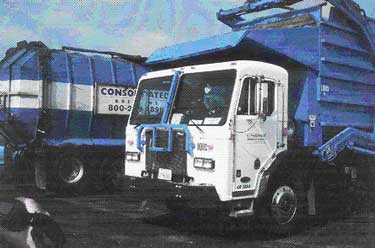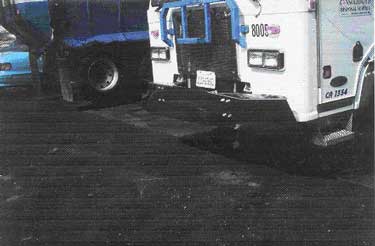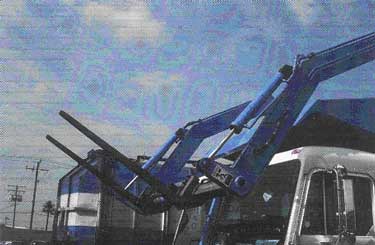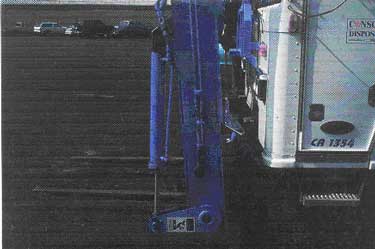A Laborer Died When Crushed Between the Forks and the Cab of a Trash Truck
Investigation: # 03CA002
SUMMARY
A Hispanic laborer died when he was crushed between the forks and cab of a trash truck with front loader hydraulic forks. The victim was standing facing the cab when the truck operator lowered the forks. The truck operator standing outside the trash truck was using the side mounted controls to lower the forks and did not see the victim. The operator did not check in front of the trash truck before lowering the forks. Workers were instructed not to enter the area of the forks. The CA/FACE investigator determined that in order to prevent future occurrences employers, as part of their Injury and Illness Prevention Program (IIPP), should:
- Ensure truck operators check in front of trash trucks before lowering hydraulic forks.
- Ensure employees stay clear of the arc of the trash truck’s forks.
- Consider installing concave mirrors on trash trucks with side mount controls.
- Ensure employees are trained on trash truck operation and safety and their knowledge of their duties and responsibilities is verified through a testing program.
INTRODUCTION
On February 17, 2003, at approximately 12:30 p.m., a 41-year-old Hispanic laborer was killed when he was crushed by the forks on a trash truck. The CA/FACE investigator learned of this incident on February 20, 2003, through the Legal Unit of the Division of Occupational Safety and Health (Cal/OSHA). On April 23, 2003, the CA/FACE investigator traveled to the temporary employment agency that hired the victim and interviewed the company’s branch manager. On May 20, 2003, the investigator traveled to the company for whom the victim was working when the incident occurred and interviewed the safety manager and other trash truck operators. The investigator also inspected the trash truck involved in the incident. The safety programs from the temporary employment agency and the company where the victim was working were reviewed.
The victim was born in Guatemala. It is not known how long he had been in the United States. According to his employer, he did not speak or read English. The victim had a 12th grade education. The employer of the victim was a temporary employment agency that specialized in general labor. The employer had been in business for 25 years and had 10 full-time employees and approximately 250 temporary employees. The victim had been employed with the agency for two months. The temporary employment agency had a generic written safety program designed mostly for the office workers that did not provide training specific to the machinery involved in this incident. The company at which the victim was working at the time of the incident was a provider of environmental services including solid waste collection, transfer, disposal, and recycling services. This company had been in business for over 50 years and had approximately 350 employees. The victim worked at this company for two months before the incident occurred. The company at which the victim was working had an Injury and Illness Prevention Program (IIPP) written in English which included specific employees’ duties and responsibilities. Bilingual safety meetings were held monthly and were documented.
The company at which the victim was working had a training program. Training was usually accomplished by on-the-job-training (OJT) using experienced trash truck drivers and in classroom settings where the duties and responsibilities were reviewed. The operator of the trash truck involved in this incident had received training on his duties and responsibilities. This training was documented. The victim was given a copy of his duties and responsibilities in English which was reviewed with him in Spanish by the trash truck operator. There was no testing method used to determine how well the victim understood the training. The same type of training was provided to both the contract employees and permanent employees of the waste hauler.
INVESTIGATION
The site of the incident was a street in front of an apartment complex. On the day of the incident, the victim and the operator of the trash truck started their shift at 4:00 a.m. They worked steadily all morning picking up approximately 80 trash bins with the forks on the front of the trash truck prior to the incident. At approximately 9:55 a.m., they were picking up and emptying trash bins from an apartment complex. The trash truck operator sat in the cab of the trash truck to drive and operate the fork controls. After emptying a trash bin, the victim manually pushed the trash bin back into its place while the trash truck operator moved the trash truck to the next stop about 150 feet down the street. He then parked the trash truck. While waiting for the victim to bring the next trash bin to the trash truck to be emptied, the operator got out of the cab of the trash truck to remove some debris between the cab and the body of the truck around the engine. He removed the debris from that area and placed it into the “clean out door” at the front of the body of the trash truck. The truck operator then went to the controls mounted on the trash truck’s frame between the front of the bed and the driver’s side of the trash truck and lowered the forks. He did not walk in front of the trash truck to see if it was clear. As the forks lowered, he heard the victim yell so he stopped lowering the forks. He ran to the front of the trash truck and found the victim trapped between the forks and the cab of the trash truck. The forks were crushing the victim’s chest into the bumper of the trash truck. The paramedics were called and they used jacks to free the victim. The victim was transported to the hospital where he died from his injuries hours later.
CAUSE OF DEATH
The cause of death, according to the death certificate, was blunt force injury to the torso.
RECOMMENDATIONS/DISCUSSION
Recommendation #1: Ensure trash truck operators check in front of trucks before lowering hydraulic forks.
Discussion: An operator of this particular type of trash truck has a clear view of the front forks while seated in the driver’s seat, but the view is obstructed when using the side controls. The operator must physically check the area in front of the trash truck, to ensure it is clear immediately before using the side controls. In this case, the operator was momentarily distracted when he took time to clear out some loose trash that had fallen on the truck exhaust system. During that time period the conditions changed when the victim entered the area in front of the trash truck below the raised forks.
Recommendation #2: Ensure employees stay clear of the arc of the trash truck’s forks.
Discussion: Employers should make sure that all employees who work with or near trash trucks are aware of the hazards that are associated with trash trucks even if they are not the operator. The company supplied written rules and regulations for all employees to follow. These rules stated that workers should never stand under the area of the fork travel and should always let the driver know where they are. Safe work practices can be assured through programs of training, supervision, rewards, and progressive disciplinary measures.
Recommendation #3: Consider installing convex mirrors on trash trucks with side mount controls.
Discussion: When operating the controls on the driver’s side of the equipment, the operator does not have a clear and unobstructed view of the front of the trash truck. A convex mirror mounted on the cab or bumper could provide the necessary view for the operator. These mirrors could supplement, not replace, visual inspection of the front of the trash truck, and possibly could help eliminate any future incidents of this type.
Recommendation #4: Ensure employees are trained on trash truck operation and safety and their knowledge of their duties and responsibilities is verified through a testing program.
Discussion: Training should be communicated in a language that each employee can understand. It should then be verified through a program that assures employers that employees understand their duties and responsibilities, and that they have attained the necessary skills to perform them when necessary. In this situation, the victim’s understanding of the duties and responsibilities was never tested. A testing program, whether it is written, oral, or demonstration, assures employers that employees are knowledgeable of the factors necessary to do their job safely.
REFERENCES
- California Code of Regulations, Vol. 9, Title 8, Sections 4345
FATALITY ASSESSMENT AND CONTROL EVALUATION PROGRAM
The California Department of Health Services, in cooperation with the California Public Health Institute, and the National Institute for Occupational Safety and Health (NIOSH), conducts investigations on work-related fatalities. The goal of this program, known as the California Fatality Assessment and Control Evaluation (CA/FACE), is to prevent fatal work injuries in the future. CA/FACE aims to achieve this goal by studying the work environment, the worker, the task the worker was performing, the tools the worker was using, the energy exchange resulting in fatal injury, and the role of management in controlling how these factors interact.
NIOSH funded state-based FACE programs include: Alaska, California, Iowa, Kentucky, Massachusetts, Michigan, Minnesota, Nebraska, New Jersey, New York, Oklahoma, Oregon, Washington, West Virginia, and Wisconsin.
To contact California State FACE program personnel regarding State-based FACE reports, please use information listed on the Contact Sheet on the NIOSH FACE website. Please contact In-house FACE program personnel regarding In-house FACE reports and to gain assistance when State-FACE program personnel cannot be reached.
EXHIBITS
 |
|
Exhibit #1. Picture of the trash truck involved in the incident.
|
 |
|
Exhibit #2. Picture of the front of the trash truck where the victim was crushed.
|
 |
|
Exhibit #3. Picture of the hydraulic forks being lowered in front of the cab.
|
 |
|
Exhibit #4. Picture of the forks lowered in front of the cab showing the space where the victim was crushed.
|
